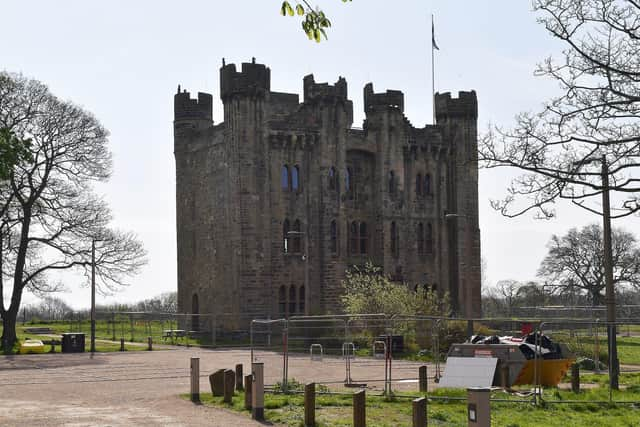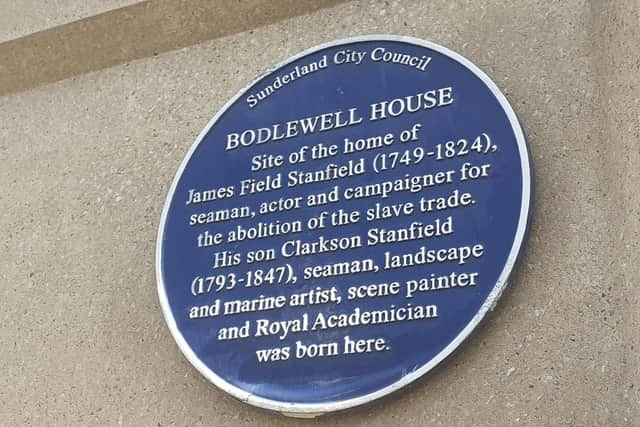Wearside's role in the rise - and fall - of the slave trade
and live on Freeview channel 276
Oh that it were so simple. Events over the weekend prove that the issue is still extremely potent. In Bristol a statue of slave trader, dead for 300 years, was toppled as anger spilled over during the current wave of anti-racism protests.
The western port cities of Bristol, Glasgow and Liverpool in particular have deep and murky ties with Britain’s slave trade, and the immense wealth it created at the expense of up to 12 million kidnapped Africans.
Advertisement
Hide AdAdvertisement
Hide AdBut what was the role of Sunderland in this repellent saga? Although not considered to be at the forefront of one of history’s great embarrassments, one prominent Wearside family in particular had blood on their hands.


However, it was an adopted Mackem who played a pivotal role in its abolition.
The Hiltons - shameless slave owners
The Hiltons were a rich and powerful family who owned Hilton Castle, which had a slight name change to Hylton Castle in the 19th century and remains a familiar Sunderland landmark. The Hiltons were seafarers who also forged links with the Caribbean.
Anthony Hilton acquired a tobacco plantation and became governor of St Kitts in the West Indies in 1625. Other family members settled in America and around the Caribbean.
Advertisement
Hide AdAdvertisement
Hide Ad

Growing their businesses needed intensive labour on their land, but they had no intention of actually paying anybody to work. Their needs were met by abducted Africans.
In the 1740s another member of the dynasty, Ralph Hilton, born in County Durham in 1710, had also settled in Jamaica. He and several other Hiltons went on to own sugar plantations there.
There are over 5,000 people with the surname Hylton in Jamaica today, but this is hardly a proud legacy for Sunderland. Most of those Hyltons/Hiltons are descended from the enslaved Africans on the plantations, who had the surname forced upon them.
Ralph Hilton died in New York in 1753.


George Washington
A far more famous Wearside name is also inextricably tangled with the slave trade. Washington.
Advertisement
Hide AdAdvertisement
Hide AdFive generations of the family lived in Washington Old Hall. John Washington from Sulgrave emigrated to Virginia in 1656. His great-grandson, the USA’s first president, George Washington, was born on his father’s slave plantation in the state in 1732.
When his father Augustine Washington died in 1743, George assumed ownership of the family estate which included 316 slaves. This didn’t sit well with George who, it should be remembered, was only 11 when he assumed the inheritance.
When George Washington died in 1799, his will decreed that all his slaves be freed upon the death of his wife Martha. This was unusual at the time and few other slave owners followed his example.
Sunderland-built slave ship.
Following abolition in Great Britain in 1807, the trade in human beings continued illegally, or within loopholes. British ships regularly flew the American flag as the trade was legal in the USA until 1865.
Advertisement
Hide AdAdvertisement
Hide AdOne such ship was The Orange Grove, thought to have been built on the River Wear in 1812. It is believed to have originally traded in fruit from the Caribbean Islands, but later became a slave vessel.
Wearside's good guys in the slavery story – Milbanke and Castlereagh.
In 1791 Sir Ralph Milbanke was elected an MP for County Durham, which then included Sunderland. He lived in Seaham Hall (his daughter Annabella married the poet Byron there in 1815).
Milbanke was a committed abolitionist and took part in a key parliamentary vote against the slave trade. He was a key ally of William Wilberforce, the most celebrated of the abolitionists and a fellow MP.
Advertisement
Hide AdAdvertisement
Hide AdMilbanke stood down from his seat in 1821 and died in 1825. Seaham Hall passed into the ownership of Lord Stuart, who later became the third Marquess of Londonderry.
His elder brother, the second Marquess of Londonderry, better known as Lord Castlereagh, was Foreign Secretary from 1812 to 1822, when he negotiated treaties which restricted the slave trade of Portugal and Spain, and prevented British slave ships from sailing under foreign flags.
But it wasn’t just the rich and powerful who actively opposed slavery.
In the 1790s the grocers of Sunderland boycotted of West Indian sugar due to its links with slavery and instead stocked East Indian sugar.
Advertisement
Hide AdAdvertisement
Hide AdJames Stanfield – Sunderland resident and one of history’s heroes.
But there was one particular adopted Mackem, abolitionist and pamphleteer who used his experiences to convincingly and decisively argue against slavery and eventually make the practice illegal.
James Stanfield was born in Dublin in 1749. He became a merchant seaman and what he wrote about the treatment of slaves would become hugely persuasive and instrumental in its repeal. His essays created widespread revulsion of the trade.
Sailing on a voyage between 1774 and 1776 on a cargo ship from Liverpool to Benin in north-west Africa, he saw first-hand how Africans were trafficked to the West Indies on a slave ship in horrendous conditions.
Advertisement
Hide AdAdvertisement
Hide AdStanfield described the ship, which he himself sailed on, as “a floating dungeon” and in 1788 wrote Observations on a Guinea Voyage, which gave gruesome and graphic descriptions of the trip.
An outright lie had circulated, what we would now refer to as fake news, claiming life in the West Indies was preferable to slaves than what they had left behind in Africa.
Stanfield’s pamphlets described the truth and gave stomach-churning descriptions of the treatment of both the enslaved Africans and the ship’s crew.
What Stanfield saw.
One horribly memorable passage told of a sadistic captain who had a female slave flogged before him in his cabin for some or other trivial offence.
Advertisement
Hide AdAdvertisement
Hide AdThe sailor administering the punishment was deemed not to be sufficiently enthusiastic about his task. So he too was flayed and the woman flogged again “until her back was full of holes”.
Stanfield bandaged the unfortunate woman himself as the ship’s doctor had died.
His accounts were serialised in British and American newspapers. It took some years for his writings to have the desired effect, but the Abolition of the Slave Trade Act was eventually passed on March 27, 1807. A volume of his works was published a year later and dedicated to Sir Ralph Milbanke.
A man with an extremely varied CV, Stanfield later became an actor and made Sunderland his home for more than 20 years.
Advertisement
Hide AdAdvertisement
Hide AdHe was also a wine and spirit merchant in High Street East between 1793 and 1796. A blue plaque in honour of Stanfield and his artist son, Clarkson Stanfield, can be seen today on an apartment block opposite the Exchange Building.
Two of his daughters were christened round the corner in the Holy Trinity Parish Church.
Legacy.
The American academic Professor Marcus Rediker, author of the 2007 book The Slave Ship: A Human History, described James Stanfield as “an unrecognised hero of the movement to abolish the slave trade”.
Sunderland has therefore made a telling contribution to both sides of the shameful story of the slave trade. It might be wise to remember all of it: both the noble and the deplorable.